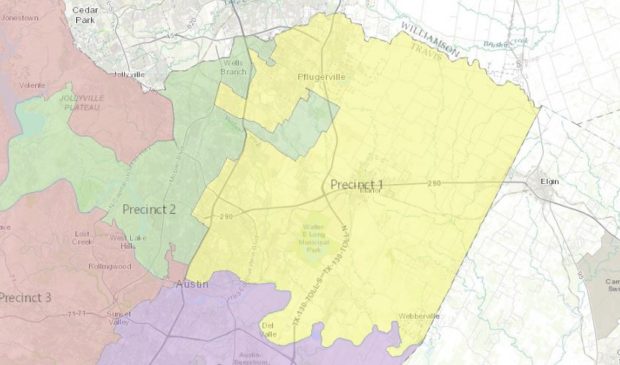Travillion ready to hit the ground running
Thursday, January 5, 2017 by
Caleb Pritchard As newly minted Travis County Commissioner Jeff Travillion moves into his office at 700 Lavaca Street, the Precinct 1 representative is unpacking an ambitious agenda for 2017.
“There will be a lot of measuring,” Travillion told the Austin Monitor in an interview on Wednesday inside the office he had just inherited from former Commissioner Ron Davis, who retired after 18 years on the dais.
Travillion won his November election by piling up nearly 70 percent of the vote against Republican Pat McCord and the Green Party’s Ashely “Flashe” Gordon. He also easily secured the Democratic nomination in the May primary runoff following a commanding performance in a five-man field during the original March primary.
As he did during his campaign, Travillion explained to the Monitor this week that his priorities include transportation and affordability.
“In a city that is so prosperous, it is a sin and a shame to have a poverty rate that is rising at the levels that it’s rising at,” he said. “And it’s going to take deliberate action.”
According to the Community Advancement Network, the county’s poverty rate decreased to 13 percent in 2015, lower than its recent peak of 19 percent in 2010. However, that means that nearly 154,000 residents lived beneath the federal threshold of poverty which is defined as annual income of less than $24,000 for a family of four. The lion’s share of residents and households barely scraping by are found east of Interstate 35. Travillion’s precinct occupies the northeast quadrant of the county.
The commissioner said he will work with the Capital Metropolitan Transportation Authority and other stakeholders to expand public transit options via park-and-ride facilities to communities outside of Austin’s urban core.
“If we’re in an area that is creating jobs, we have got to build a better system of transportation for getting low- to moderate-income people to the jobs that will take them out of poverty,” Travillion explained before adding, “And that’s going to mean a park-and-ride system that focuses on the eastern part of Travis County that gets you from Pflugerville, that gets you from Manor, that gets you from Elgin, that gets you from Del Valle.”
Travillion acknowledged that many of the areas he is thinking of are outside of Capital Metro’s service area. However, he insisted, “We’ve got to develop some system and we’ve got to sit down and talk about how we share costs.”
Before he even took office, Travillion began to steer the Commissioners Court towards his vision by advocating for a broader search for a county appointee to the Capital Area Metropolitan Planning Organization Transportation Policy Board. In December, Travillion convinced the court to forego the automatic reappointment of Lakeway Mayor Joe Bain to the seat and instead issue a call for applications. He explained told the Monitor that he would at least like to consider increasing the diversity on a board that is mostly white.
“Every time we make an appointment, every time we talk about a committee, I want there to be people who have an operational understanding of what’s going on, and then I want diversity of thought. Sometimes that moves beyond just race. Sometimes that moves beyond geographic location,” said Travillion, who himself is a resident of Pflugerville. “I want to make sure that different frames of thought and different perspectives are brought to the table.”
Travillion also explained that investing in transportation infrastructure is a way to redistribute wealth into his precinct. He predicted that the city of Austin’s successful $720 million mobility bond that voters approved in November will funnel money into projects that will help “not only small businesses, but also folks who might have even gotten in trouble before the opportunity to get a job that will provide a living wage.”
And even as the public investments ease the county’s rapid growth, Travillion said he favors managing development with the aim of ensuring that it attracts services to communities where grocery stores and medical offices are currently scarce.
He cited projects within Austin such as Circle C Ranch and Mueller as models for leveraging public investments to guide private development. While the county has fewer options for shaping growth in its unincorporated lands, the court now counts among its tools public improvement districts, which can be used to entice builders to provide beneficial infrastructure.
“We’ve got to make sure that we’re providing the types of resources that attract private capital and ultimately development shares the burden of growth,” said Travillion.
The Austin Monitor’s work is made possible by donations from the community. Though our reporting covers donors from time to time, we are careful to keep business and editorial efforts separate while maintaining transparency. A complete list of donors is available here, and our code of ethics is explained here.
You're a community leader
And we’re honored you look to us for serious, in-depth news. You know a strong community needs local and dedicated watchdog reporting. We’re here for you and that won’t change. Now will you take the powerful next step and support our nonprofit news organization?




